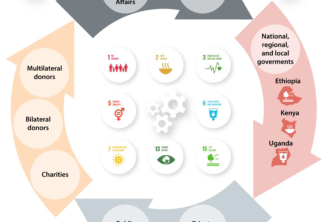
Project
Ethiopia multi-level study of interactions with SDG15 (Life on land)
This is a five-year project funded by the Dutch Research Agenda Theme "SDG Interactions and Policy Interventions in Developing Countries" with FNP focussing on a case study of multi-level study of interactions with SDG15 (Life on land): the challenge of landscape restoration in Ethiopia - Governing SDG interactions
Numerous governments, businesses, and civil society organisations aim to contribute to achieving the 17 Sustainable Development Goals in the global South. However, cherry-picking SDGs coupled with lack of alignment between initiatives means trade-offs are not addressed and opportunities for synergy are missed.
Progress towards achieving the SDGs is hampered by international development projects duplicating efforts on the ground; lack of coherence between donor policies; misalignment between national policies and multilateral development programmes; and diverging private sector investments. Aligning SDG efforts by these public and private actors operating across levels has itself become a challenge that will determine whether SDGs will be met in 2030.
Together with our international, Dutch and East-African partners, this project will study the effectiveness of governance mechanisms that aim to align SDG efforts between (1) donors’ domestic and foreign policies, (2) donors and recipients, (3) different donors, and (4) public and private initiatives. By working across disciplines and with stakeholders, we will produce actionable research results. Policy briefs with tailored recommendations for co-designing inclusive and effective polycentric governance arrangements will be produced. We aim to support better alignment between development actors and efforts, so as to minimise trade-offs, maximise synergies, and achieve the SDGs in Ethiopia, Kenya and Uganda.
In our case study country Ethiopia, SDG15 (Life on land) is the starting point for studying trade-offs and synergies with other SDGs for a multi-level study of interactions the challenge of landscape restoration. We study 'Governing synergies and trade-offs with SDG15 in from a local-to-global and global-to-local perspective for landscape restoration in Lake Tana sub-basin in the Ethiopian highlands, where agricultural expansion, overgrazing, and fuelwood collection have led to ongoing deforestation and soil erosion. Land degradation threatens food security and impacts water quantity and quality downstream. This combination of challenges, that reinforce each other, makes the Lake Tana sub-basin an important and relevant case study for understanding how integrative landscape management and restoration may address multiple SDGs at once and such an approach is linked to national and international levels of decision-making.
The local-to-global approach study conducted by Aytenew Tatek starts from the actions of local actors, to trace how their role in landscape restoration and governance shapes, and is shaped by, national and international actors. Specifically, how and to what extent an integrative landscape management and governance is able to address interactions between various SDGs. There is a strong focus on forest conservation and reforestation, and attention to food, water quality and quantity, and climate change mitigation and adaptation. The project explores how local recipients of donor funds and local private actors (i.e. farmers, industry) interact with national government, international donors, and other relevant actors and policy platforms. the governance of synergies and trade-offs in Ethiopian landscape restoration from a global to local perspective.
The global-to-local study conducted by Dereje Amene Yimam, starts from the actions of global actors and platforms such as the Dutch ministry of foreign affairs, the UN High Level Policy Forum on Sustainable Development in New York, and national climate commitments made under the Paris agreement. It then traces how these actors and policies align with other public and private actors in various centers of governance, including on the national and local level. the interactions between various SDGs – related to forest, water, food, and climate, among others – in multiple centers of governance are investigated. Ultimately, we map and trace different forms of alignment between global, national, regional, and local actors and discuss these in the context of the landscape approach.
